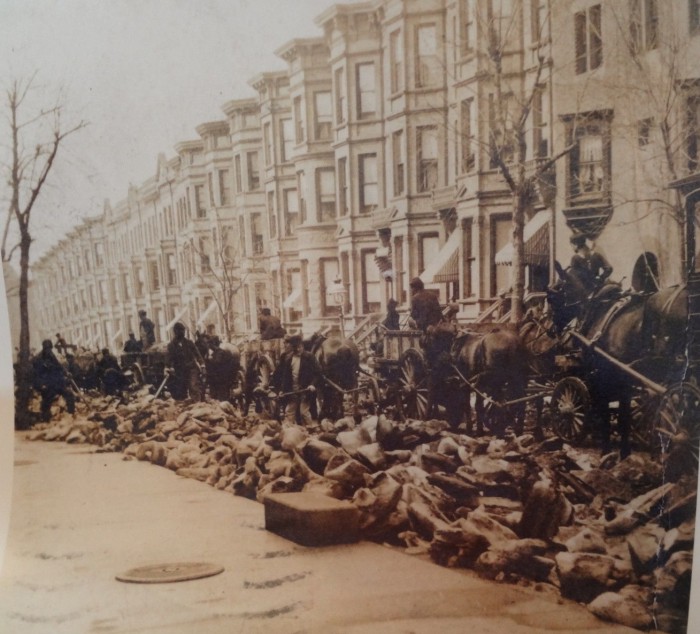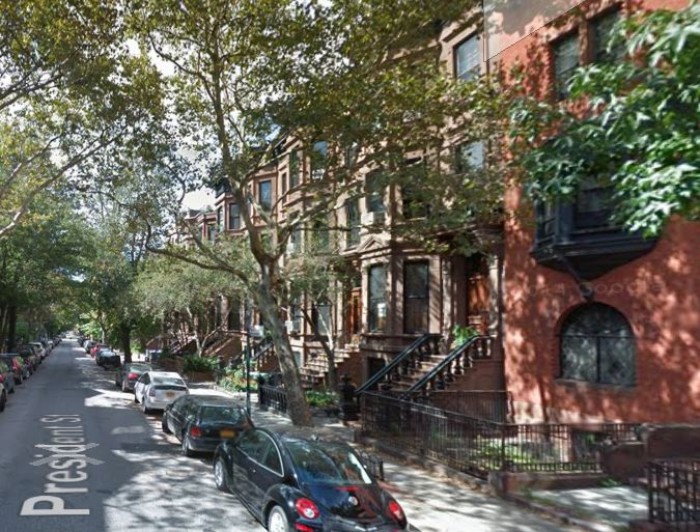Past and Present: The Sidewalks of President Street in Park Slope
A look at Brooklyn, then and now. One of the fun parts of writing this particular column is matching a vintage photo or postcard to its present-day site. Sometimes a perfect match is possible, and other times, the scenery has changed so much, it’s impossible to tell exactly where a building or event was located….

1906 Photograph: Ebay

A look at Brooklyn, then and now.
One of the fun parts of writing this particular column is matching a vintage photo or postcard to its present-day site. Sometimes a perfect match is possible, and other times, the scenery has changed so much, it’s impossible to tell exactly where a building or event was located. The clues or markers that place or date a photo just don’t exist any longer. But that’s not the case here.
The historic photograph was taken in late February or early March of 1906 on President Street, between 7th and 8th avenues. This is the north side of the street, closer to 8th Avenue. The men are tearing up the sidewalk area to lay down new sidewalks and curbs.
My vintage photo had a caption, President Street, 1906, which narrowed down the street and date. A bit of research turned up public notices in the Brooklyn Eagle announcing road and sewer work throughout the borough, as well as the “regulating, grading, curbing, flagging and laying cement sidewalks” on many blocks, as well.
The paving and road work were spread out with great planning, so traffic, both vehicular and pedestrian, could get around without too much difficulty. The notices began appearing at the end of February, 1906, and continued through March. One by one, block by block, the city infrastructure was improved.
It’s interesting to see how they did this. I am amazed at the number of large rocks in the photograph. I don’t know if these were dug up in the course of laying the sidewalks, or if they were brought in as a solid foundational base for the actual sidewalks. I suspect the latter.
Even though automobiles and trucks were rolling on the streets at this time, the horse and wagon was still the way to go for projects like this. It’s difficult to see exactly what the men and wagons are doing. Are they leaving or picking up the stone? Compacting or combing the dirt evenly before laying the walkways? Or just hanging out waiting for something?

1906 photograph: eBay
The large rectangular block of stone on the street is a mounting block for a carriage. These were everywhere in wealthier neighborhoods. The step down from a carriage to the sidewalk was pretty high. A mounting block bridged that gap, and made the step up or down much easier and certainly more graceful for both sexes.
The mounting block is in front of the eclectic Steward Lyndon Woodford house, at 869 President Street. The unique bay windows were a powerful clue. You can also see the tiny window in the center of the house on the second floor, as well as the arch of the ground floor window. This well-known house, designed by Henry Ogden Avery in 1885, is a one-of-a-kind home, as well as a distinctive marker from which to identify the block.
The other interesting details in the 1906 photo are the striped canvas awnings that almost every row house had in their parlor floor entryways, as well as the young trees, which appear to be just about to bud for spring.
Today, the trees are mature, and the sidewalks seem to be a combination of the old bluestone, which probably dates from this photo, and concrete. Is the concrete a replacement pavement, or the original? Perhaps a reader can provide some answers.

Photo: Google Maps









I love Past and Present when things all stay the same.
Dear Montrose, lemme try my hand at theorizing here. To these weary old eyes, those objects don’t look like rocks; they look like crumpled pieces of lead pipe. And there are men among them with sledgehammers to mash them into even more manageable form. The wagons are lined up to haul it all away. Or it is simply traffic backed up due to construction.
Or: if they are rocks (weird, weird rocks), perhaps the trenches for the sewer lines had to be deepened and the workers are hauling away rocks that were extracted. I’m guessing they would probably not backfill with rocks, knowing that utilities need to be dug up again and again.
The sidewalk looks freshly poured (too bad; bluestone is so much nicer) and is being kept clear of stuff, except in the distance. It even seems to have a bit of a wet sheen.
The trees in the modern pic are definitely too small to be 109 years old. Second, maybe third generation.
Hope to see u soon in Troy.
Is the print of the photo accessible? Magnifying glass at the ready here!